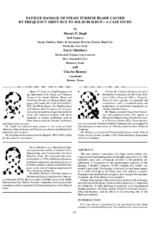| dc.contributor.other | Turbomachinery Symposium (23rd : 1994) | |
| dc.creator | Singh, Murari P. | |
| dc.creator | Matthews, Terryl | |
| dc.creator | Ramsey, Charles | |
| dc.date.accessioned | 2017-10-05T14:10:04Z | |
| dc.date.available | 2017-10-05T14:10:04Z | |
| dc.date.issued | 1994 | |
| dc.identifier.uri | https://hdl.handle.net/1969.1/163480 | |
| dc.description | Lecture | en |
| dc.description | Pg. 107-114 | en |
| dc.description.abstract | The case history is presented of a large steam turbine that experienced blade damage after about eight years of service. The probable cause and subsequent solution to the problem are addressed. A discussion of the metallurgical analysis of the damage, Campbell diagram, SAFE diagram and modal test results is provided. The damage is believed to have been caused by a solid build up at the blade root that shifted a natural frequency into an interference region, and changed the response characteristic of the bladed disk assembly. Proper blade design with conservative stress levels and separation of natural frequency from exciting frequency is important for reliability. If solid build up is expected, or is experienced during operation, the blade design should be reviewed for possible interference, and its effect on the resulting life of the blading evaluated. | en |
| dc.format.medium | Electronic | en |
| dc.format.mimetype | application/pdf | |
| dc.language.iso | en | |
| dc.publisher | Texas A&M University. Turbomachinery Laboratories | |
| dc.relation.ispartof | Proceedings of the 23rd Turbomachinery Symposium | en |
| dc.subject.lcsh | Turbomachines | en |
| dc.title | Fatigue Damage Of Steam Turbine Blade Caused By Frequency Shift Due To Solid Buildup - A Case Study. | en |
| dc.type.genre | Presentation | en |
| dc.type.material | Text | en |
| dc.identifier.doi | https://doi.org/10.21423/R1XQ0W | |


